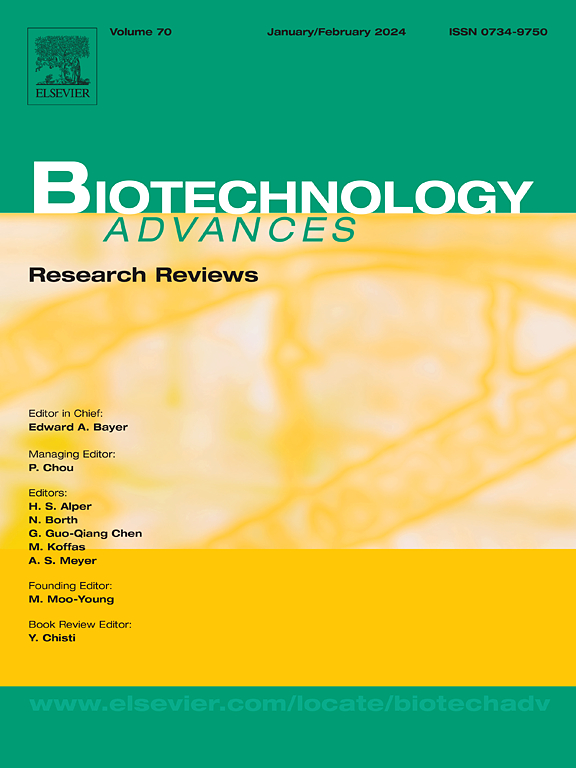Engineering encapsulated living bacteria for advanced healthcare management
IF 12.5
1区 工程技术
Q1 BIOTECHNOLOGY & APPLIED MICROBIOLOGY
引用次数: 0
Abstract
Bacterial therapies are emerging as promising alternatives to conventional treatments, particularly in the areas of intestinal therapy, oncology, and wound management. However, gastric acid, bile salts, immune cells, and reactive oxygen species in the human body hinder the colonization and growth of foreign probiotics, thereby compromising the efficacy of bacteriotherapy. Recent advancements in engineering encapsulated live bacteria strategies utilizing biopolymers to construct protective shells on the bacterial surface to significantly address the aforesaid challenges have gained unprecedented attention. The scrumptious integration of multiple probiotic species, bioencapsulation biomaterials, and on-demand encapsulation technologies offers tremendous advantages over conventional living bacterial counterparts, such as precise targeting, rapid immune activation, and synergistic therapeutic effects. This review presents the essential natures and response mechanism selectivity for encapsulation biomaterials from the design perspective of engineered bacterial therapeutics, including pH-responsive, enzyme-responsive, and reactive oxygen species (ROS)-responsive materials. Engineering bacterium requires a uniquely tailored design strategy within the polymer-targeted delivery platform. Meanwhile, the review provides an account of its recent developments and advancements in the biomedical fields, with emphasis on tissue repair, anti-inflammatory, antibacterial, anti-tumor, and other therapeutic applications. Finally, challenges and emerging trends in its clinical translation are expounded. By highlighting the potential of bacteria to revolutionise the therapeutic landscape, this review offers valuable insights into the design of innovative disease treatment paradigms and alternatives to conventional drug therapy, and facilitates the clinical applications of engineering encapsulated living bacteria.
工程封装活菌先进的医疗保健管理
细菌治疗正在成为传统治疗的有希望的替代方法,特别是在肠道治疗、肿瘤学和伤口处理领域。然而,人体内的胃酸、胆盐、免疫细胞和活性氧阻碍了外来益生菌的定植和生长,从而影响了细菌治疗的效果。近年来,利用生物聚合物在细菌表面构建保护壳的工程封装活菌策略取得了前所未有的进展,从而显著解决了上述挑战。多种益生菌物种的美味整合,生物包封生物材料和按需包封技术与传统的活菌对应物相比具有巨大的优势,例如精确靶向,快速免疫激活和协同治疗效果。本文从工程细菌治疗学的设计角度,综述了包封性生物材料的基本特性和反应机制选择性,包括ph响应性、酶响应性和活性氧(ROS)响应性材料。工程细菌需要在聚合物靶向递送平台内独特的定制设计策略。同时,综述了其在生物医学领域的最新进展,重点介绍了其在组织修复、抗炎、抗菌、抗肿瘤和其他治疗方面的应用。最后,阐述了其临床翻译面临的挑战和新趋势。通过强调细菌革新治疗领域的潜力,本综述为创新疾病治疗范例的设计和传统药物治疗的替代方案提供了有价值的见解,并促进了工程封装活细菌的临床应用。
本文章由计算机程序翻译,如有差异,请以英文原文为准。
求助全文
约1分钟内获得全文
求助全文
来源期刊

Biotechnology advances
工程技术-生物工程与应用微生物
CiteScore
25.50
自引率
2.50%
发文量
167
审稿时长
37 days
期刊介绍:
Biotechnology Advances is a comprehensive review journal that covers all aspects of the multidisciplinary field of biotechnology. The journal focuses on biotechnology principles and their applications in various industries, agriculture, medicine, environmental concerns, and regulatory issues. It publishes authoritative articles that highlight current developments and future trends in the field of biotechnology. The journal invites submissions of manuscripts that are relevant and appropriate. It targets a wide audience, including scientists, engineers, students, instructors, researchers, practitioners, managers, governments, and other stakeholders in the field. Additionally, special issues are published based on selected presentations from recent relevant conferences in collaboration with the organizations hosting those conferences.
 求助内容:
求助内容: 应助结果提醒方式:
应助结果提醒方式:


